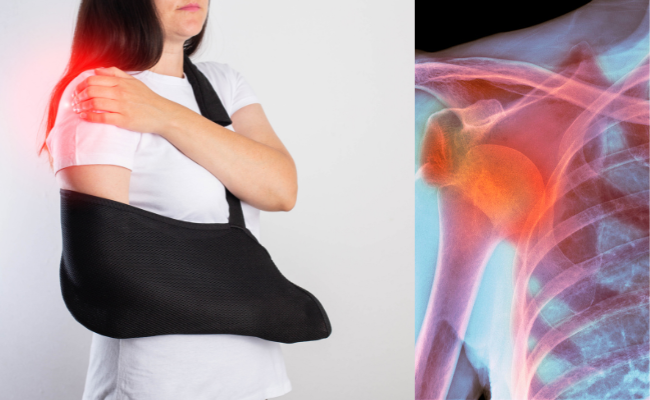How to Treat Dislocated Shoulder?
- February 15, 2024
- No Comments

What is a Dislocated Shoulder?
A dislocated shoulder is an injury where the upper arm bone comes out of the shoulder blade socket. It happens commonly due to falls, sports-related incidents, or sudden impacts to the shoulder. This injury requires prompt medical care because it causes severe pain and immobility. Symptoms include an out-of-place shoulder, swelling, and an inability to move the joint. When someone experiences these symptoms, it's crucial to seek immediate medical attention to address the injury effectively.
Why Does a Dislocated Shoulder Happen?
Several factors contribute to a dislocated shoulder. One primary cause is trauma, such as a fall onto an outstretched arm or a direct blow to the shoulder during sports activities like football or rugby. Additionally, certain medical conditions, such as loose ligaments or a history of shoulder dislocations, can predispose individuals to this injury. Furthermore, engaging in high-risk activities without proper warm-up or protective gear increases the likelihood of shoulder dislocation.
How to Identify a Dislocated Shoulder?
Recognizing the signs of a dislocated shoulder is crucial for prompt treatment. Common symptoms include intense pain, swelling, and bruising around the shoulder area. The shoulder may appear visibly deformed, with the arm appearing longer than usual and an inability to move it. Additionally, individuals may experience numbness or tingling down the arm, indicating potential nerve damage. If you suspect a dislocated shoulder, it's essential to seek medical help immediately to prevent further complications.
Treatment Solutions for Dislocated Shoulders
- Medical Intervention: Upon reaching a healthcare facility, a medical professional will conduct a physical examination and may order imaging tests like X-rays or MRIs to confirm the diagnosis. In most cases, the shoulder will need to be manipulated back into its socket—a procedure known as closed reduction. This is typically performed under sedation or anesthesia to alleviate pain and facilitate muscle relaxation. Following successful reduction, the shoulder may be immobilized with a sling or brace to promote healing.
- Physical Therapy: After the initial phase of treatment, physical therapy plays a crucial role in restoring shoulder strength, flexibility, and function. A tailored exercise program, supervised by a physiotherapist, helps prevent recurrent dislocations and enhances overall shoulder stability. These exercises focus on strengthening the muscles surrounding the shoulder joint, improving range of motion, and enhancing proprioception—your body's awareness of its position in space.
- Surgical Intervention: In cases of severe shoulder dislocations or recurrent instability, surgical intervention may be necessary to repair damaged ligaments or tissues. Surgical options include arthroscopic procedures, where small incisions are made to access and repair the injured structures, or open surgery for more complex cases. Surgical management aims to restore shoulder stability and reduce the risk of future dislocations, especially in individuals with high physical demands or athletic aspirations.
Benefits of Treating Dislocated Shoulders
- Pain Relief: One of the primary benefits of treating a dislocated shoulder is pain relief. When the shoulder is out of place, it can cause intense pain due to the strain on surrounding tissues and nerves. Prompt medical care, including repositioning the shoulder joint and managing inflammation, helps alleviate discomfort, allowing individuals to resume their daily activities with reduced pain levels.
- Prevention of Complications: Treating a dislocated shoulder promptly reduces the risk of developing complications. Without proper treatment, complications such as nerve damage, chronic instability, and arthritis may arise. By addressing the injury early on, medical professionals can minimize the likelihood of long-term complications, preserving shoulder function and overall joint health.
- Restoration of Functionality: Effective treatment restores functionality to the shoulder joint, enabling individuals to regain mobility and perform daily tasks with greater ease. Physical therapy plays a crucial role in this aspect, as it helps strengthen the muscles surrounding the shoulder, improve range of motion, and enhance overall joint stability. Through targeted exercises and rehabilitation techniques, individuals can gradually restore full shoulder function and flexibility.
- Prevention of Recurrence: Proper treatment of a dislocated shoulder reduces the likelihood of recurrence. Physical therapy plays a crucial role in this aspect by addressing underlying weaknesses or imbalances in the shoulder joint and surrounding musculature. By strengthening the muscles and improving joint stability, individuals are less prone to experiencing future dislocations, thereby minimizing the risk of reinjury and maintaining long-term shoulder health.
- Enhanced Quality of Life: Treating a dislocated shoulder positively impacts an individual's quality of life by restoring confidence and independence. The ability to move the shoulder without pain or restriction allows individuals to participate in activities they enjoy, whether it's sports, hobbies, or simply performing everyday tasks. This restoration of function promotes overall well-being and contributes to a higher quality of life.
Comments (0)